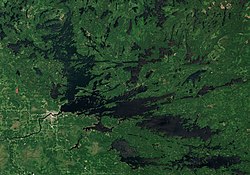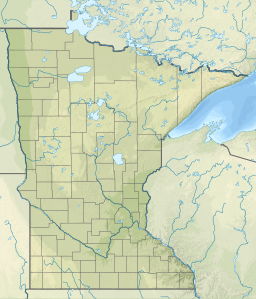| Rainy Lake | |
|---|---|
 Characteristic shoreline and islands of Rainy Lake | |
 | |
| Location | Minnesota, United States; Ontario, Canada |
| Coordinates | 48°38′13″N 93°01′53″W / 48.6369°N 93.0314°W |
| Type | remnant of former glacial Lake Agassiz |
| Primary inflows | Namakan Lake Kabetogama Lake Seine River |
| Primary outflows | Rainy River |
| Basin countries | Canada, United States |
| Max. length | 80 km (50 mi) |
| Max. width | 48 km (30 mi) |
| Surface area | 932 km2 (360 sq mi) |
| Max. depth | 50 m (160 ft) highly variable |
| Shore length1 | 1,500 km (930 mi) 2,520 km (1,570 mi) (w/ Islands) highly irregular, rocky shoreline |
| Surface elevation | 338 m (1,109 ft) |
| Islands | ~2,568[1] |
| Settlements | International Falls, Minnesota Ranier, Minnesota Fort Frances, Ontario |
| 1 Shore length is not a well-defined measure. | |
Rainy Lake (French: lac à la Pluie; Ojibwe: gojiji-zaaga'igan) is a freshwater lake with a surface area of 360 square miles (932 km2) that straddles the border between the United States and Canada. The Rainy River issues from the west side of the lake. Today it is harnessed to make hydroelectricity for US and Canadian locations. International Falls, Minnesota and the much smaller city of Ranier, Minnesota are situated opposite Fort Frances, Ontario, on either side of the Rainy River. Rainy Lake and Rainy River establish part of the boundary between the US state of Minnesota and the Canadian province of Ontario.[2]
Voyageurs National Park is located on the southeastern corner of the lake, where it connects with Kabetogama and Namakan lakes at Kettle Falls. Rainy Lake is part of an extremely large system of lakes forming the Hudson Bay drainage basin that stretches from west of Lake Superior north to the Arctic Ocean. The Rainy Lake watershed includes the Boundary Waters Canoe Area Wilderness (BWCA), portions of the Superior National Forest on the US side of the border, and the Quetico Provincial Park on the Canadian side of the border.[3]
For exploration and fur trade history, see Winnipeg River and additional references below.[4][5]
- ^ Rahm, Joe. Island Images: Rainy Lake’s missing islands. The Journal. 14 Feb. 2010.
- ^ Geographical Place Names of Voyageurs National Park (PDF), 2008, retrieved 2013-07-25
- ^ "Rapid Watershed Assessment: Rainy Lake" (PDF). Natural Resources Conservation Service, United States Department of Agriculture. Archived from the original (PDF) on 2022-10-06. Retrieved 2017-07-16.
- ^ Douglas A. Birk; Jeffrey J. Richner (2004), From Things Left Behind: Fur Trade Sites and Artifacts, Voyageurs National Park and Environs, 2001-2002, Midwest Archeological Center and Institute for Minnesota Archaeology, MAC Technical Report Number 84, IMA Reports of Investigation Number 606, retrieved 2017-07-16
- ^ Ted Catton; Marcia Montgomery, Special History: The Environment and the Fur Trade Experience in Voyageurs National Park, 1730-1870, retrieved 2017-07-16

